For the past few years, I've put together a "State of the Hood" (see
2007,
2008, and
2009) detailing what's gone on in Near Southeast during the previous year, and what's on the boards for the coming months. During the incredible explosion of development in the area, these missives grew into overwhelming recitations of all the completed, underway, and about-to-start projects that characterized the land rush in the neighborhood during the height of the real estate bubble and the frenzy to be part of the landscape near the new
Nationals Park.
For 2010's State of the Hood, though, not so much.
I was ready to make all sorts of cracks about how this was the Year of Nothing, thanks to the continuing shakiness of the banking and commercial real estate sectors in the city, region, and country. It was certainly what I was expecting for 2009, as is plain from last year's "
looking ahead" portion. And yet, as I look back, it's clear that plenty of milestones were hit in the neighborhood over the past 12 months, even if it didn't match the rate of progress of 2006 through 2008. And the area even started to have more than a smattering of residents, bringing a very different feel to Near Southeast, which had been without much of a population for quite a few years.
Here's my rundown for what happened over the past 12 months, and what might be expected to come down the pike in 2010.
For the first years of Near Southeast's revitalization, the focus was all on the facts of commercial redevelopment--how many buildings were planned? How many square feet? When would they start? But then, in late 2008 and 2009, a funny thing started happening--large numbers of people actually started moving into the neighborhood.
The
Capitol Riverfront BID estimates the current residential population to be close to 2,800 people, and the occupancy numbers for the new residential projects show that buildings have been very successful in getting tenants (even though, it must be said, it was done mainly by offering big deals on rents and other amenities like parking, which made Near Southeast a far more affordable place to rent than most other close-in DC neighborhoods).
The current numbers, courtesy of the BID:
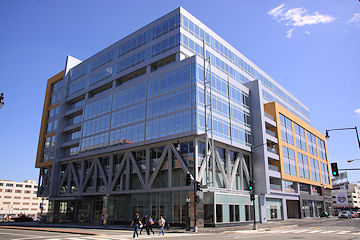 55 M Street
55 M Street -- Monument Realty's 275,000-sq-ft office building on top of the west entrance to the Navy Yard Metro station at Half and M reached "substantial completion" in January, was host to
Artomatic in June and July, and
snagged its first tenant in October. But with Monument having become somewhat of a poster child for the flying-high-crashing-hard development companies hit by the recession, some of the focus was not on 55 M but on the hole in the ground just to its south, where perhaps someday the residential and hotel portion of Monument's vision for Half Street will get underway.
|
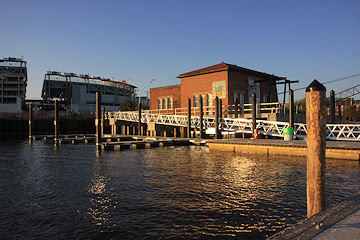
Diamond Teague Park/Piers
A project by the DC government with nowhere near the profile of Canal Park a few blocks away, this 39,000-sq-ft park just across the street from the baseball stadium was completed in late summer 2009, although its gates remain closed most of the time outside of baseball games.
|
|

909 New Jersey Avenue
With little fanfare or drama, JPI's third building in what it called its Capitol Yards development opened in the spring, offering 237 rental units in a "luxury" building. Ground floor retail space, as of now, remains unfilled.
|
|
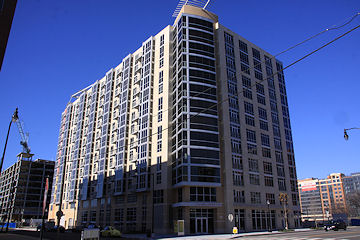
Velocity Condos
A more difficult birthing process was had by the 200-unit condo building at 1025 First Street. Construction had begun in spring 2007, but it wasn't until November 2009 that the first move-ins took place, and the tightening of financial rules for condo loans made the process of completing purchases much more difficult, resulting in only a handful of tenants by the end of the year.
|
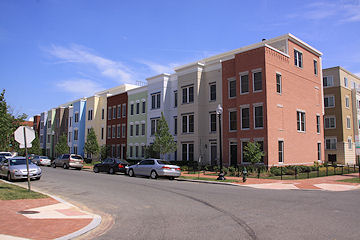 While neither a "completion" nor a "start," perhaps the biggest milestone in 2009 was the opening of Capitol Quarter, the mixed-income townhouse development on the site of the old Capper/Carrollsburg public housing project. With a combination of market-rate and "workforce-rate" for-sale homes alongside public housing units, the strip between Fourth and Fifth Street from I south to L began to be transformed into a neighborhood after years of waiting. Move-ins continued throughout 2009, and at the end of the year framing was beginning on the last block of Phase 1, along Virginia Ave., Third, Fourth, and I.
While neither a "completion" nor a "start," perhaps the biggest milestone in 2009 was the opening of Capitol Quarter, the mixed-income townhouse development on the site of the old Capper/Carrollsburg public housing project. With a combination of market-rate and "workforce-rate" for-sale homes alongside public housing units, the strip between Fourth and Fifth Street from I south to L began to be transformed into a neighborhood after years of waiting. Move-ins continued throughout 2009, and at the end of the year framing was beginning on the last block of Phase 1, along Virginia Ave., Third, Fourth, and I.
Other milestones for 2009, big and small:
Retail and Recreation:
As the resident population of Near Southeast grew throughout 2009, interest in any new retail offerings in the neighborhood increased markedly, although there were few breakthroughs to report. The rundown:
The most welcome addition to the area for residents was probably Cornercopia, a market and deli on the southwest corner of Third and K that opened in August, offering a spot other than CVS or 7-11 to buy sandwiches, beer and wine, and other provisions.
The Bullpen pitched its tent on rented land at Half and N in May, offering ballpark-goers a place outside the stadium to grab a beer or snack, with live music often on the bill as well.
And Domino's returned to the neighborhood--after leaving its spot at 1500 South Capitol in 2008--as the first offering at 900 M, an old car dealership building that was rehabbed as a retail building.
(Wachovia and SunTrust branches opened in 2009 as well, though their arrivals did not seem to have residents dancing in the streets.)
Work also got underway on Justin's Cafe, a new pizza/sandwich/salad joint with a full bar in the ground floor of Velocity expected to open in early 2010, which has neighbors tapping their toes in expectation.
Elsewhere, though, available retail spaces in multiple buildings (20 M, Capitol Hill Tower, 909 New Jersey) remained empty, with some choice locations becoming less enticing to retailers because of ownership/financial problems with the buildings themselves (Opus East's 100 M and Monument's 55 M).
The biggest draw that brings outsiders to the neighborhood is, of course,
Nationals Park, where the Nationals struggled to a 53-109 record in the stadium's second season, drawing
1.8 million fans to the ballpark over the course of 80 home games. This placed the team 24th out of 30th in the major league, with its average of 22,716 tickets sold per game a substantial drop from the inaugural season's 29,005 average. The stadium also hosted its first big-deal concert, with the
Billy Joel/Elton John "Face 2 Face" tour selling out the venue when it came through town on July 10.
And 2009 also brought
Artomatic to Near Southeast, with 75,000 patrons coming to
55 M Street in June and July to check out nine floors of offerings from local artists.
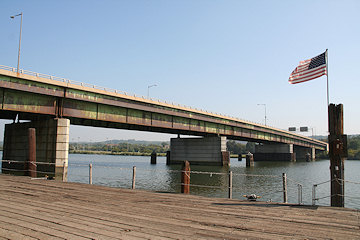 In late December, the city announced that work was getting underway on the new 11th Street Bridges, which will see the construction of two new spans with eight freeway lanes and four local lanes to improve the connections between the east and west sides of the Anacostia River. Large-scale disruptions to the existing traffic flow are not expected to happen until 2011, and the new bridges are expected to open in 2013.
In late December, the city announced that work was getting underway on the new 11th Street Bridges, which will see the construction of two new spans with eight freeway lanes and four local lanes to improve the connections between the east and west sides of the Anacostia River. Large-scale disruptions to the existing traffic flow are not expected to happen until 2011, and the new bridges are expected to open in 2013. On March 29, the city launched a new route for its Circulator buses, running between Union Station, Eastern Market, and the Navy Yard Metro station on weekdays, with additional weeknight and weekend service during events at the stadium. This replaced the old Metro N22 route, with the hope that the spiffier buses with the (hopefully?) more reliable every-10-minute schedules would entice more people to use public transportation to get to the neighborhood.
The launch in September of water taxi service to and from Diamond Teague Park and Alexandria for baseball games added another option to the neighborhood's "multimodal transportation" portfolio, and it will be interesting to see if the service is expanded in 2010, perhaps to National Harbor and/or Georgetown.
Perhaps the most notable transportation "departure" of 2009 was in early April when, after years of promises, the DC school system closed down their school bus lot operations at Second and L. Within weeks, the three blocks that had been surrounded with cyclone fences and overgrown brush were cleared and sodded, providing a temporary open space for residents (and their dogs) while waiting for Canal Park's construction to get underway.
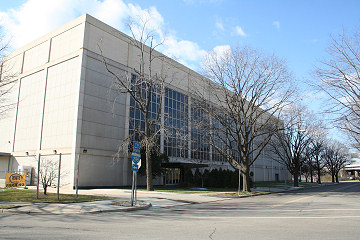 After 2 1/2 years of paying $500,000 a month in rent, and after being unable to find any developer interested in subletting, the city bit the bullet and paid $85 million to purchase the old Washington Star/Post printing plant 225 Virginia Avenue. After renovating the building, the city plans to house three agencies there (Child and Family Services, the Office of the Chief Technology Officer, and the Commission on the Arts and Humanities), although no date for these moves has been announced.
After 2 1/2 years of paying $500,000 a month in rent, and after being unable to find any developer interested in subletting, the city bit the bullet and paid $85 million to purchase the old Washington Star/Post printing plant 225 Virginia Avenue. After renovating the building, the city plans to house three agencies there (Child and Family Services, the Office of the Chief Technology Officer, and the Commission on the Arts and Humanities), although no date for these moves has been announced. In a year where many media outlets ran pieces on the "ghost town" around Nationals Park, the news of the first office tenants being signed at 20 M and 55 M was greeted with relief by developers and residents alike. In August it was announced that the Bureau of Land Management would be leasing 95,000 square feet on four floors at 20 M (which Lerner Enterprises had completed in 2007), and in October the news came out that Sayres & Associates would take 20,000 square feet at 55 M.
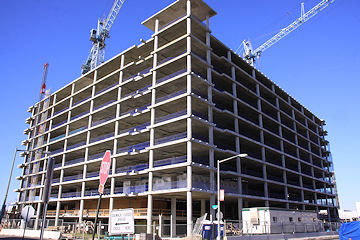 In early summer, sharp-eyed observers noticed that work had stopped on the 440,000-square-foot office building at 1015 Half Street, and within weeks it was announced that developer Opus East was filing for Chapter 7 liquidation. Opus, which also owned the office building at 100 M, was caught in the money crunch that claimed developers all across the U.S. in 2009. In October the Douglas Wilson Companies announced it had been appointed receiver for both buildings, and would be re-starting construction on Half Street, but no work has yet been seen.
In early summer, sharp-eyed observers noticed that work had stopped on the 440,000-square-foot office building at 1015 Half Street, and within weeks it was announced that developer Opus East was filing for Chapter 7 liquidation. Opus, which also owned the office building at 100 M, was caught in the money crunch that claimed developers all across the U.S. in 2009. In October the Douglas Wilson Companies announced it had been appointed receiver for both buildings, and would be re-starting construction on Half Street, but no work has yet been seen.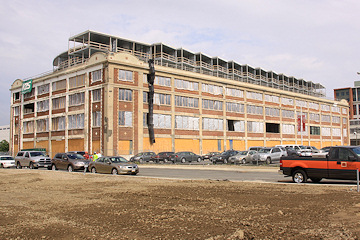 Another project where construction halted in 2009 was the renovation of Building 160 at the Yards, where work stopped in January with the framing of the two new floors as part of the plans to create the Foundry Lofts. Developer Forest City said that it was continuing to look for funding, and hoped to complete the project in 2010, but as of January 2010 no announcement had been made.
Another project where construction halted in 2009 was the renovation of Building 160 at the Yards, where work stopped in January with the framing of the two new floors as part of the plans to create the Foundry Lofts. Developer Forest City said that it was continuing to look for funding, and hoped to complete the project in 2010, but as of January 2010 no announcement had been made. JPI had been a big player in Near Southeast with its "Capitol Yards" plans, and although it successfully launched three of the buildings (70 and 100 I and 909 New Jersey), but the real estate downtown took a big bite out of the company's operations, and in summer 2009 they defaulted on the $25 million loan for 47,000 square feet of land at 23 I Street. After a foreclosure sale brought no bidders, the land fell into the hands of Ruben Companies, which had purchased the loan a few months earlier.
Foreclosures also struck some existing single-family homes in the neighborhood, as well as investment properties near Eighth Street, with one site along Potomac Avenue and Ninth Street heading to auction a second time after the first $2.461 million bid fell through.
Last year, in
looking forward to what might happen in 2009, I ran through all the on-the-boards projects and assessed the likelihood that any might get started. But, for 2010, with no starts yet announced and with little feel that the engine of commercial real estate development is getting past the sputtering stage, I'm only going to concentrate on the most likely events to come over the next 12 months.
Expected Completion in 2010
|
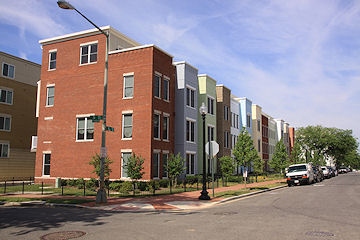
Capitol Quarter Phase 1
With residents ranging from deep-pocketed market-rate purchasers to Capper public housing inhabitants returning home, Capitol Quarter has started to become a real neighborhood as Phase 1 continues to deliver units. The last first-phase homes are expected to be completed by summer.
|
|
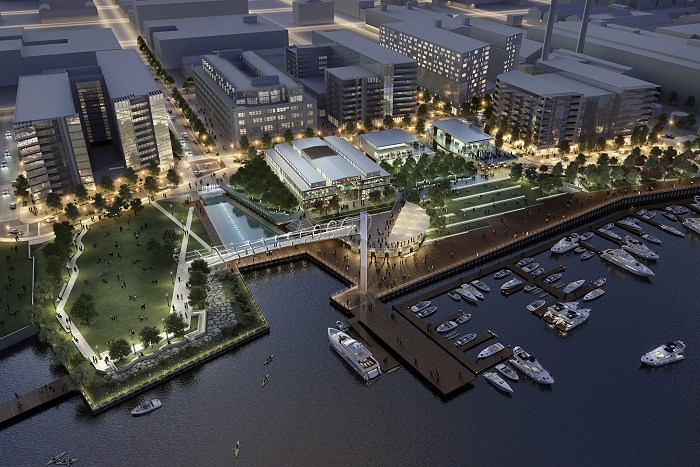
The Park at The Yards
A $42 million public-private partnership was struck late in 2008 to finance the construction of this 5.5-acre waterfront space that is at the forefront of plans to transform the banks of the Anacostia River. The first phase is expected to open in 2010.
|
|
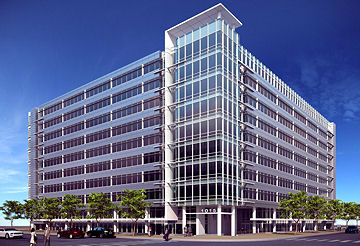
1015 Half
It would seem that, if construction can re-start early in 2010, this 440,000-sq-ft office building should be able to be completed by the end of the year. But it's been three months since Douglas Wilson Companies said construction would be starting again, and still no movement.
|
Starts in 2010?
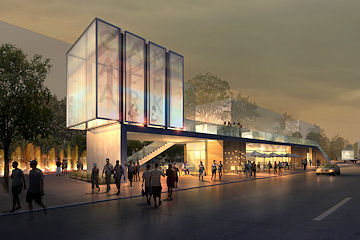 The start date has slipped again, but it still seems to be expected that construction on Canal Park at Second Street could begin in fall 2010. A new design company was hired in 2009 and the site was cleared, but the passage of time and the creation of a temporary open space that has been embraced by the community as a dog park and gathering area seems to have perhaps lessened the hankering for this project that was once such a focus of neighbors' attention.
The start date has slipped again, but it still seems to be expected that construction on Canal Park at Second Street could begin in fall 2010. A new design company was hired in 2009 and the site was cleared, but the passage of time and the creation of a temporary open space that has been embraced by the community as a dog park and gathering area seems to have perhaps lessened the hankering for this project that was once such a focus of neighbors' attention.
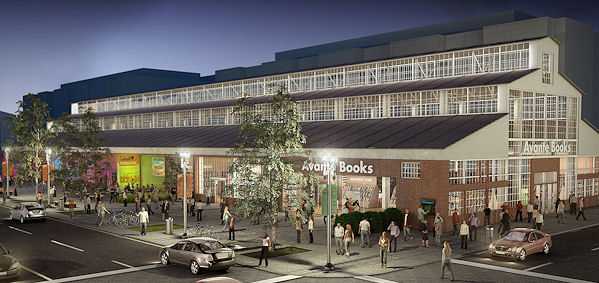 As mentioned above, Forest City hopes to not only restart the work on the Foundry Lofts at the Yards, but also perhaps begin work on their 46,000-sq-ft retail pavilion in the historic Boilermaker Shops building at Third and Tingey. Rumors abound of signed tenants, but no disclosures have been made, and no start date has been publicly announced.
As mentioned above, Forest City hopes to not only restart the work on the Foundry Lofts at the Yards, but also perhaps begin work on their 46,000-sq-ft retail pavilion in the historic Boilermaker Shops building at Third and Tingey. Rumors abound of signed tenants, but no disclosures have been made, and no start date has been publicly announced.
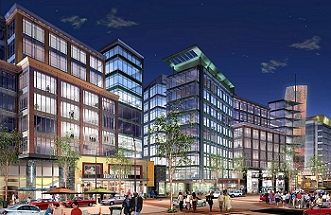 When unveiling its three-building, 700,000-square-foot mixed use project on Half Street just north of the ballpark, Akridge originally gave a start date of January 2010, "subject to market conditions." The market conditions would seem to have stalled this project, with January coming and going with no new timeline having been announced. One question that ballpark visitors may be asking: does this mean the Bullpen will get another year of life at Half and N?
When unveiling its three-building, 700,000-square-foot mixed use project on Half Street just north of the ballpark, Akridge originally gave a start date of January 2010, "subject to market conditions." The market conditions would seem to have stalled this project, with January coming and going with no new timeline having been announced. One question that ballpark visitors may be asking: does this mean the Bullpen will get another year of life at Half and N?
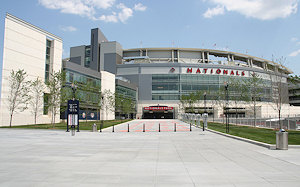 As for Nationals Park, the question for 2010 has less to do with the building and more to do with the lineup--will the signing of pitcher/phenom Stephen Strasburg portend a turnaround for the team, and bring with it an increase in the number of baseball-related visitors to Near Southeast? Conversely, will the end of the "Nats Express" shuttle bus service from the (free) parking lots at RFK bring an increase in gameday congestion?
As for Nationals Park, the question for 2010 has less to do with the building and more to do with the lineup--will the signing of pitcher/phenom Stephen Strasburg portend a turnaround for the team, and bring with it an increase in the number of baseball-related visitors to Near Southeast? Conversely, will the end of the "Nats Express" shuttle bus service from the (free) parking lots at RFK bring an increase in gameday congestion?
One possible new addition to the neighborhood's multimodal transportation portfolio could be coming in 2010, with the city looking at adding two bike lanes along M Street, from 11th St., SE, to Sixth St., SW. However, at this point little is known about this project beyond a presentation made to BID members in late 2009.
While many people have been impatient with the lack of progress on some big-ticket projects, others (like bloggers still exhausted from the whirlwind surrounding the opening of the stadium in 2008) looked on 2009 as a chance for Near Southeast to catch up with all of the development that had happened during the Great Land Rush. The city stepped in to move some projects forward, and newly arrived residents began turning the area from a "concrete canyon" filled only with office workers and baseball fans to an actual neighborhood. It looks likely that 2010 will continue in a similar vein to 2009, with modest progress on smaller projects (especially those with public dollars involved), while perhaps later in the year the commercial real estate world will rebound enough to see some new private projects get underway.
To see the latest on these projects and others in the months and years to come,
visit my Project Directory for quick info on what's coming and what's here.
Also, for figures on what's been built and started in Near Southeast since 1999,
see Development Since 1999, By the Numbers.
The BID's 2009 Annual Report may also be of interest.


 55 M Street -- Monument Realty's 275,000-sq-ft office building on top of the west entrance to the Navy Yard Metro station at Half and M reached "substantial completion" in January, was host to Artomatic in June and July, and snagged its first tenant in October. But with Monument having become somewhat of a poster child for the flying-high-crashing-hard development companies hit by the recession, some of the focus was not on 55 M but on the hole in the ground just to its south, where perhaps someday the residential and hotel portion of Monument's vision for Half Street will get underway.
55 M Street -- Monument Realty's 275,000-sq-ft office building on top of the west entrance to the Navy Yard Metro station at Half and M reached "substantial completion" in January, was host to Artomatic in June and July, and snagged its first tenant in October. But with Monument having become somewhat of a poster child for the flying-high-crashing-hard development companies hit by the recession, some of the focus was not on 55 M but on the hole in the ground just to its south, where perhaps someday the residential and hotel portion of Monument's vision for Half Street will get underway.
 While neither a "completion" nor a "start," perhaps the biggest milestone in 2009 was the opening of Capitol Quarter, the mixed-income townhouse development on the site of the old Capper/Carrollsburg public housing project. With a combination of market-rate and "workforce-rate" for-sale homes alongside public housing units, the strip between Fourth and Fifth Street from I south to L began to be transformed into a neighborhood after years of waiting. Move-ins continued throughout 2009, and at the end of the year framing was beginning on the last block of Phase 1, along Virginia Ave., Third, Fourth, and I.
While neither a "completion" nor a "start," perhaps the biggest milestone in 2009 was the opening of Capitol Quarter, the mixed-income townhouse development on the site of the old Capper/Carrollsburg public housing project. With a combination of market-rate and "workforce-rate" for-sale homes alongside public housing units, the strip between Fourth and Fifth Street from I south to L began to be transformed into a neighborhood after years of waiting. Move-ins continued throughout 2009, and at the end of the year framing was beginning on the last block of Phase 1, along Virginia Ave., Third, Fourth, and I.




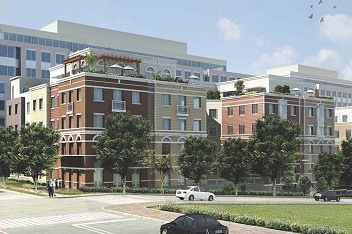 The redevelopment of the sprawling Capper/Carrollsburg received a boost in late 2009 with public monies both from HUD and expected bond sales allowing plans to continue to move forward. Look for an announcement in early 2010 on the financing for Phase 2 of the Capitol Quarter townhomes as well as a new mixed-income apartment building at Seventh and L streets, on the site of the old Capper Seniors building.
The redevelopment of the sprawling Capper/Carrollsburg received a boost in late 2009 with public monies both from HUD and expected bond sales allowing plans to continue to move forward. Look for an announcement in early 2010 on the financing for Phase 2 of the Capitol Quarter townhomes as well as a new mixed-income apartment building at Seventh and L streets, on the site of the old Capper Seniors building.  The start date has slipped again, but it still seems to be expected that construction on Canal Park at Second Street could begin in fall 2010. A new design company was hired in 2009 and the site was cleared, but the passage of time and the creation of a temporary open space that has been embraced by the community as a dog park and gathering area seems to have perhaps lessened the hankering for this project that was once such a focus of neighbors' attention.
The start date has slipped again, but it still seems to be expected that construction on Canal Park at Second Street could begin in fall 2010. A new design company was hired in 2009 and the site was cleared, but the passage of time and the creation of a temporary open space that has been embraced by the community as a dog park and gathering area seems to have perhaps lessened the hankering for this project that was once such a focus of neighbors' attention. As mentioned above, Forest City hopes to not only restart the work on the Foundry Lofts at the Yards, but also perhaps begin work on their 46,000-sq-ft retail pavilion in the historic Boilermaker Shops building at Third and Tingey. Rumors abound of signed tenants, but no disclosures have been made, and no start date has been publicly announced.
As mentioned above, Forest City hopes to not only restart the work on the Foundry Lofts at the Yards, but also perhaps begin work on their 46,000-sq-ft retail pavilion in the historic Boilermaker Shops building at Third and Tingey. Rumors abound of signed tenants, but no disclosures have been made, and no start date has been publicly announced. When unveiling its three-building, 700,000-square-foot mixed use project on Half Street just north of the ballpark, Akridge originally gave a start date of January 2010, "subject to market conditions." The market conditions would seem to have stalled this project, with January coming and going with no new timeline having been announced. One question that ballpark visitors may be asking: does this mean the Bullpen will get another year of life at Half and N?
When unveiling its three-building, 700,000-square-foot mixed use project on Half Street just north of the ballpark, Akridge originally gave a start date of January 2010, "subject to market conditions." The market conditions would seem to have stalled this project, with January coming and going with no new timeline having been announced. One question that ballpark visitors may be asking: does this mean the Bullpen will get another year of life at Half and N?  As for Nationals Park, the question for 2010 has less to do with the building and more to do with the lineup--will the signing of pitcher/phenom Stephen Strasburg portend a turnaround for the team, and bring with it an increase in the number of baseball-related visitors to Near Southeast? Conversely, will the end of the "Nats Express" shuttle bus service from the (free) parking lots at RFK bring an increase in gameday congestion?
As for Nationals Park, the question for 2010 has less to do with the building and more to do with the lineup--will the signing of pitcher/phenom Stephen Strasburg portend a turnaround for the team, and bring with it an increase in the number of baseball-related visitors to Near Southeast? Conversely, will the end of the "Nats Express" shuttle bus service from the (free) parking lots at RFK bring an increase in gameday congestion?